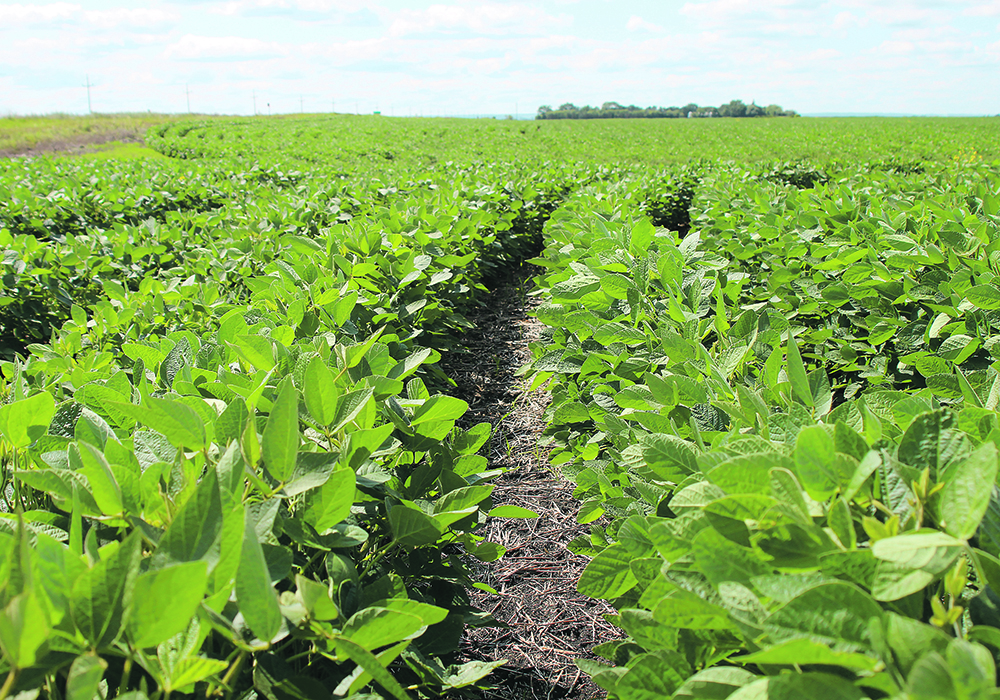The pest needs to be caught early because it cannot be eradicated, only managed, once it is established in an area
ST JEAN BAPTISTE, Man. — Now is the time to scout for the silent thief of soybean yields.
Once you start noticing that soybean cyst nematode is in your fields, it might already be widespread.
“We want to detect it as soon as possible so we can minimize the amount and the populations in our field,” said Laura Schmidt, a production specialist with Manitoba Pulse and Soybean Growers, in an interview at St Jean Farm Days.
“The sooner we can find it in our fields, the earlier we can manage it.”
Read Also

Drones now used to assess wildlife crop damage in Saskatchewan
Wildlife damage in Saskatchewan crops is now assessed by drones and artificial intelligence.
Schmidt said once the pest is established, it can’t be eradicated. It can only be managed.
Soybean cyst nematode is a microscopic ground worm that preys on roots of many species of plants, including soybeans and dry beans. The cysts it creates on roots suck away nutrients and damage the plant’s ability to thrive, causing yield losses in crops.
However, crops can appear fine above the surface even if they are suffering 30 percent yield losses, so looking beneath the soil surface is essential to spot infestations.
The cysts begin as white or yellowish, darkening with time, and are lemon-shaped. They are much smaller than the nitrogen-fixing nodules on pulse crop roots. Farmers must be gentle when extracting soybean roots for examination because the cysts easily separate from the host.
Schmidt said farmers should check different parts of their fields during the growing season, especially in July and August. It might seem like a hassle, but it’s the only way to spot the problem before it spreads and seriously damages yields.
“Up till now we’ve (often) put them in the ground and maybe do a herbicide pass and (otherwise) ignoring them. Let’s add a visit,” said Schmidt.
“Let’s dig up roots and look throughout the summer.”
Even when infestations do become visible above the surface, they can be misidentified as either drought stress or iron deficiency chlorosis, two common soybean problems. Only a root inspection will reveal the true source of the problems.
The good news is that the pest spreads slowly, so it can be managed by diligent producers. It doesn’t inevitably spread across a field in large numbers once it appears in a patch.
However, farmers also need to worry about the pest lingering even in non-soybean years, since it can infest more than 100 weed species as well. Tall waterhemp is a common host, as are many traditional prairie weeds. If those weeds are allowed to offer sanctuary to the soybean cyst nematode, it’ll be there the next time the farmer plants soybeans.
Farmers shouldn’t despair if they find the pest in coming years, Schmidt said. It is common in American soybean areas and has been moving up the Red River Valley toward Manitoba for years. It has been found in a few fields in Manitoba already, especially where spring floodwaters allowed the pest to float in and get established
Managing soybean cyst nematode will just be another part of being a soybean grower. Farmers manage it in the United States, so it can be managed in Canada too.
It’s sad to see it finally appear in Manitoba, but not a shock.
“Up to now we were almost in a soybean honeymoon period,” Schmidt said.
“We didn’t have many pest issues.”
















